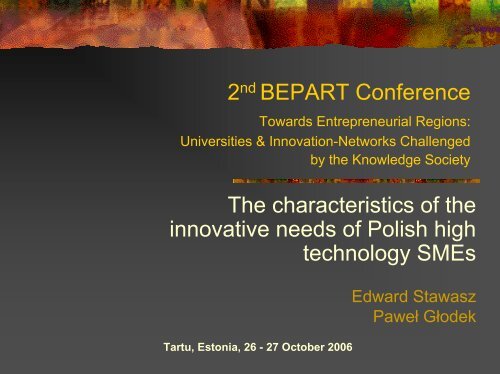Innovative needs
Innovative needs
Innovative needs
You also want an ePaper? Increase the reach of your titles
YUMPU automatically turns print PDFs into web optimized ePapers that Google loves.
2 nd BEPART Conference<br />
Towards Entrepreneurial Regions:<br />
Universities & Innovation-Networks Challenged<br />
by the Knowledge Society<br />
The characteristics of the<br />
innovative <strong>needs</strong> of Polish high<br />
technology SMEs<br />
Edward Stawasz<br />
Paweł Głodek<br />
Tartu, Estonia, 26 - 27 October 2006
<strong>Innovative</strong> <strong>needs</strong> and their suppliers<br />
Company<br />
(<strong>Innovative</strong> <strong>needs</strong>)<br />
•TRAINING<br />
•INFORMATION<br />
•FINANCE<br />
•BUSINESS NEEDS<br />
POTENTIAL<br />
SUPPLIERS<br />
•R+D SECTOR<br />
•SUPPORT<br />
INSTITUTIONS<br />
•OTHER COMPANIES<br />
•OTHERS
Data sources<br />
• LORIS project – Regional Innovation Strategy<br />
for Lodz Region<br />
• 55 face-to-face in-depth structured interviews<br />
• small or medium-sized enterprises<br />
• modern sectors, large proportion of firms’<br />
sales/production were related to new/improved<br />
products/services<br />
• comparision with outcomes of other research<br />
projects<br />
• Lower Silesia ‘04<br />
• Silesia ’02 and Silesia ‘06
<strong>Innovative</strong> abilities<br />
• innovation sources<br />
• own ideas and resources<br />
• links to the sources located outside of the<br />
region - mainly imitation strategy<br />
• limited ability to create and develop<br />
innovations, mainly in the area of<br />
monitoring, cooperation with the partners<br />
and adaptation of the external solutions
Cooperation with R+D institutions<br />
• Nearly 2/3 of the companies declare some<br />
sort of contacts with R+D institutions<br />
• Almost ½ of the companies cannot<br />
evaluate the quality of R+D offer because<br />
of too little knowledge about them<br />
• Relatively low significance of cooperation<br />
with R+D institutions
Nature of cooperation with R+D<br />
institutions<br />
• mostly institutes and HEIs – almost no<br />
industrial R+D departments<br />
• if cooperation exists, it is rather a longterm<br />
cooperation<br />
• informal ties based on the personal<br />
relationship predominate – a minimum<br />
level of formal agreements
Spin-offs vs. non spin-offs<br />
Spin-outs from R+D institutions<br />
• relatively intensive ties to R+D institutions<br />
• opinion about R+D institutions research and<br />
knowledge potential is relatively high<br />
• knowledge how to deal with people and<br />
institution<br />
Non spin-offs<br />
• limited level or simply no connections with R+D<br />
institutions<br />
• little knowledge about R+D institutions potential<br />
and possibilities to cooperate
Cooperation with enterprises in the<br />
area of innovation<br />
• Almost all interviewed enterprises cooperate in a<br />
various way with other companies in the area of<br />
innovation<br />
• Cooperation is evaluated as highly valuable<br />
• Only in one in four cases the main business<br />
partner comes from the region<br />
• In one in four cases the main business partner<br />
comes from the region – strong international ties
Cooperation with enterprises in the<br />
area of innovation<br />
• joint implementation works (e.g. the<br />
provision of assistance in the field of<br />
cooperation and joint production),<br />
• information exchange<br />
• research and technical services
Cooperation with enterprises in the<br />
area of innovation - barriers<br />
• a weak information system related to the production and<br />
technology offer of potential business partners<br />
• few opportunities for contact with other companies<br />
• not adequate technology nor the professional level of<br />
regional enterprises<br />
• excessive cost of cooperation<br />
• reluctance for cooperation shown by large companies<br />
• problems with cooperation management e.g. costs and<br />
benefits evaluation<br />
• fear of the loss of control on the company and know-how<br />
– it concerns mainly small companies
Cooperation with support<br />
institutions<br />
• very low level of cooperation – ¼ firms indicate at least<br />
some contacts with them<br />
• ’02 accidental nature of such contacts as well as a very<br />
low impact of provided support<br />
• ’04 and ’06 gradually sharpening of firms attitudes and<br />
cooperation behaviour<br />
• still low level of the knowledge about support institutions<br />
and their offer<br />
• UE funds gradually influence this situation<br />
• strengtening of suport institution sector<br />
• new experiences of SMEs
Conclusions<br />
• companies are the most important partners in<br />
the area of innovation<br />
• low level of cooperation with R+D institutions<br />
• significance of informal way of cooperation to<br />
R+D institutions<br />
• low but gradually growing significance of<br />
cooperation with support institutions<br />
• little role of region in the innovative activity<br />
• gradually changing <strong>needs</strong> and conditions of<br />
innovative activity
2 nd BEPART Conference<br />
Towards Entrepreneurial Regions:<br />
Universities & Innovation-Networks Challenged<br />
by the Knowledge Society<br />
The characteristics of the<br />
innovative <strong>needs</strong> of Polish high<br />
technology SMEs<br />
Edward Stawasz<br />
Paweł Głodek<br />
Tartu, Estonia, 26 - 27 October 2006






